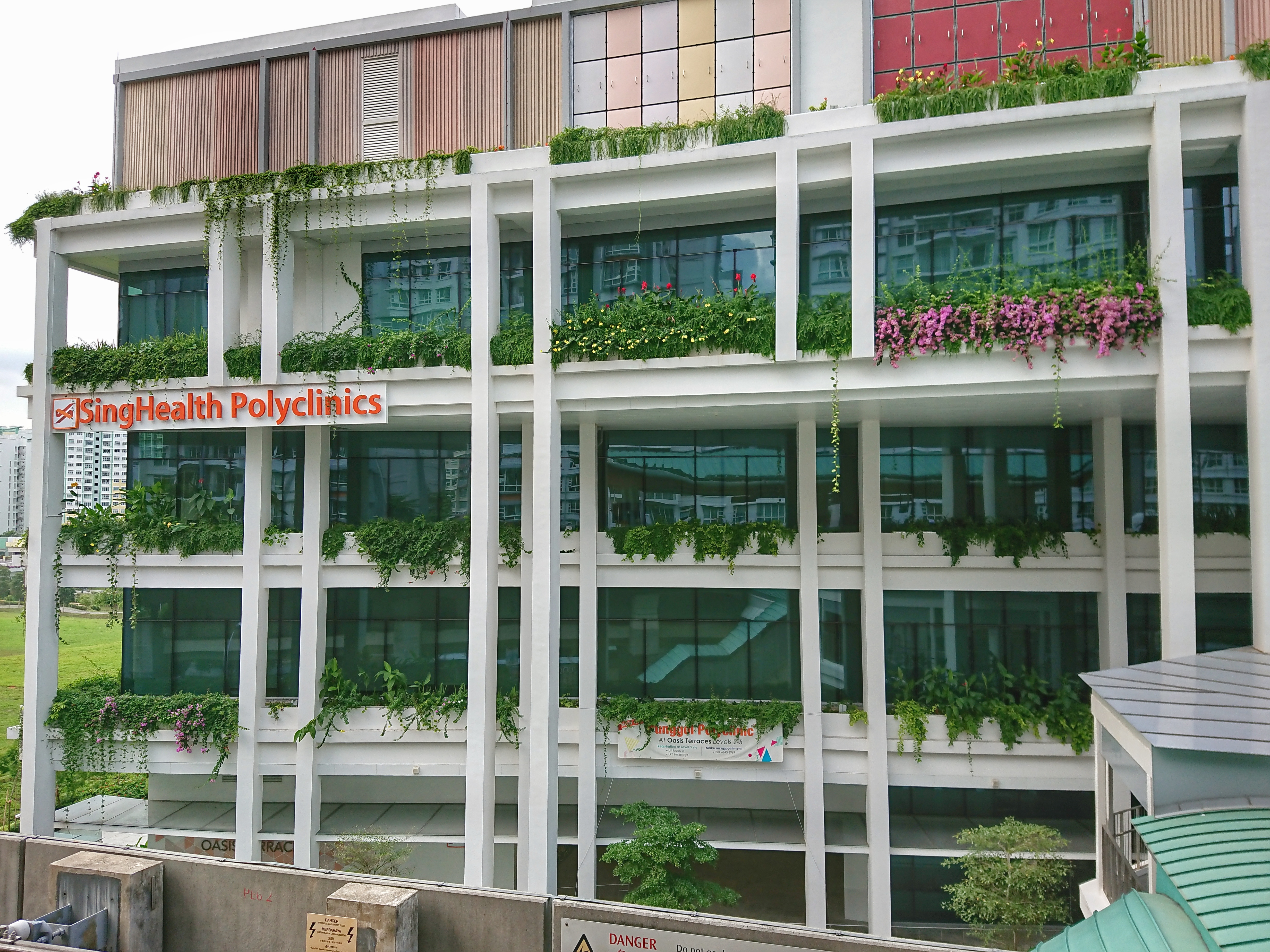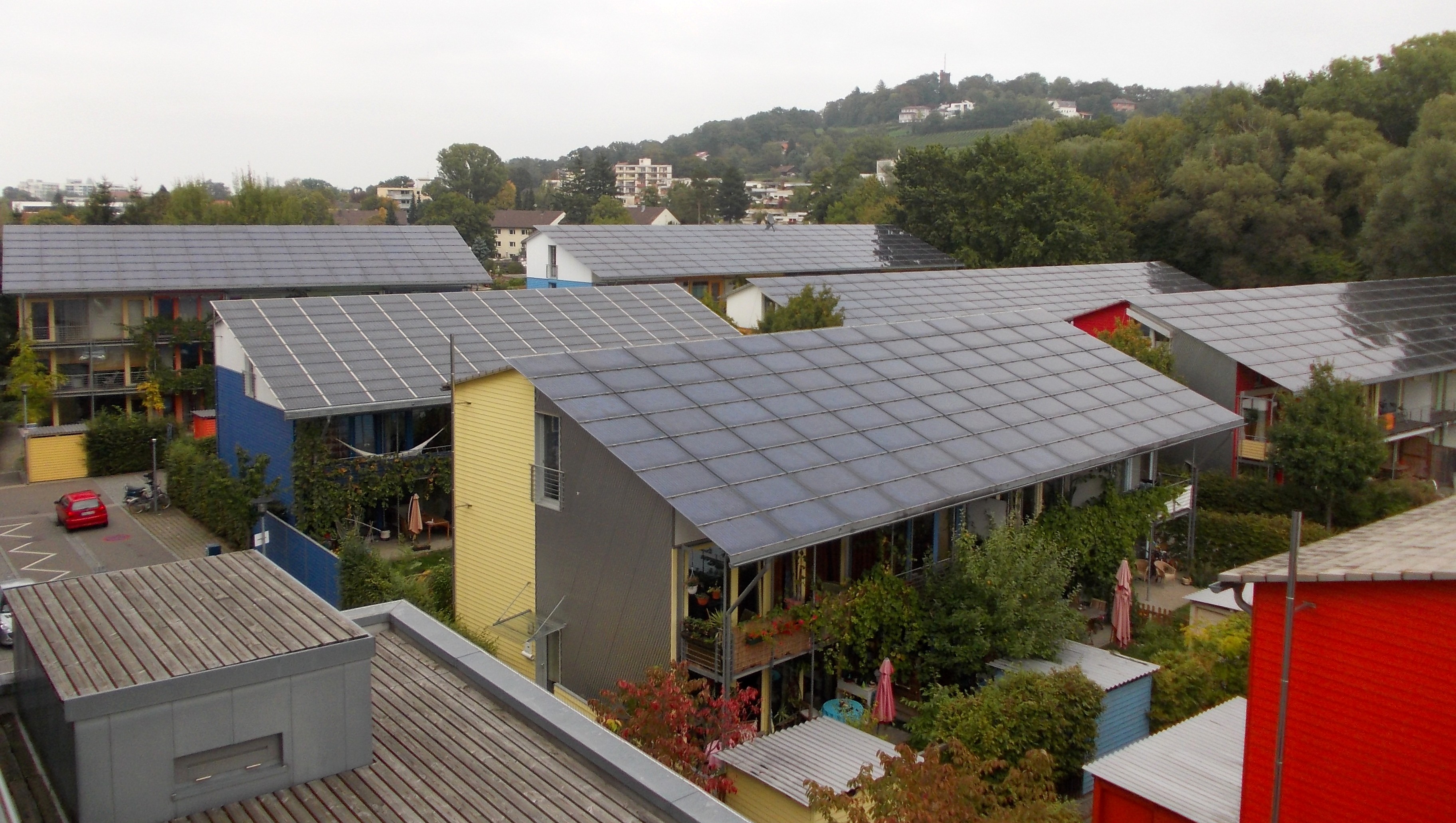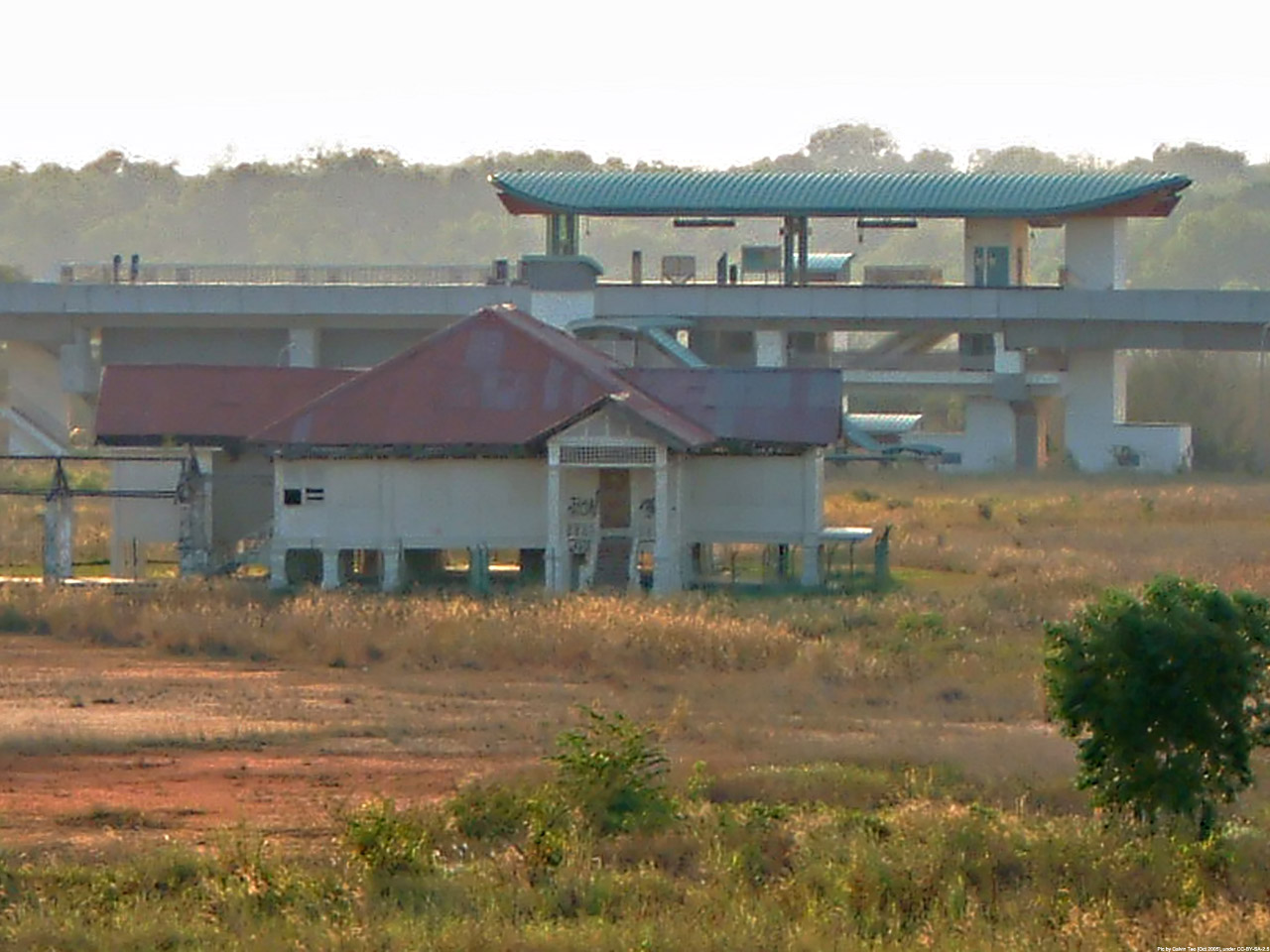|
Oasis Terraces
Oasis Terraces is an integrated development located in Punggol, Singapore, next to Oasis LRT station. Developed by the Housing and Development Board (HDB), the development was built as part of a new generation of neighbourhood centres, housing the Punggol Polyclinic, a retail component with restaurants and shops, a community plaza and a rooftop community garden. Background Oasis Terraces was announced in October 2015 by the Housing and Development Board (HDB) as part of two new neighbourhood centres in Punggol that was progressively opened on 15 June 2018 and officially opened on 17 February 2019, and the other one being Northshore Plaza that progressively opened on 29 October 2021 and officially opened on 24 July 2022. Built beside the waterway, construction began on 22 August that year and was completed in June 2018. It has a total of of gross floor area, with a retail area of spread over 5 storeys and the polyclinic occupying 4 levels. Facilities Located along the Punggol Wa ... [...More Info...] [...Related Items...] OR: [Wikipedia] [Google] [Baidu] |
Mixed-use Development
Mixed-use is a kind of urban development, urban design, urban planning and/or a zoning type that blends multiple uses, such as residential, commercial, cultural, institutional, or entertainment, into one space, where those functions are to some degree physically and functionally integrated, and that provides pedestrian connections. Mixed-use development may be applied to a single building, a block or neighborhood, or in zoning policy across an entire city or other administrative unit. These projects may be completed by a private developer, (quasi-) governmental agency, or a combination thereof. A mixed-use development may be a new construction, reuse of an existing building or brownfield site, or a combination. Use in North America vs. Europe Traditionally, human settlements have developed in mixed-use patterns. However, with industrialization, governmental zoning regulations were introduced to separate different functions, such as manufacturing, from residential areas. Public ... [...More Info...] [...Related Items...] OR: [Wikipedia] [Google] [Baidu] |
Housing And Development Board
The Housing & Development Board (HDB) (; ms, Lembaga Perumahan dan Pembangunan; ta, வீடமைப்பு வளர்ச்சிக் கழகம்) or often referred to as the Housing Board, is a statutory board under the Ministry of National Development responsible for Singapore's public housing. Founded in 1960 as a result of efforts in the late 1950s to set up an authority to take over the Singapore Improvement Trust's (SIT) public housing responsibilities, the HDB focused on the construction of emergency housing and the resettlement of kampong residents into public housing in the first few years of its existence. This focus shifted from the late 1960s, with the HDB building flats with improved fittings and offering them for sale. From the 1970s, it initiated efforts to improve community cohesion in its estates and solicit resident feedback. In the 1990s and 2000s, the HDB introduced upgrading and redevelopment schemes for mature estates, as well as new ... [...More Info...] [...Related Items...] OR: [Wikipedia] [Google] [Baidu] |
Sustainable Architecture
Sustainable architecture is architecture that seeks to minimize the negative environmental impact of buildings through improved efficiency and moderation in the use of materials, energy, development space and the ecosystem at large. Sustainable architecture uses a conscious approach to energy and ecological conservation in the design of the built environment. The idea of sustainability, or ecological design, is to ensure that our use of presently available resources does not end up having detrimental effects to our collective well-being or making it impossible to obtain resources for other applications in the long run. Background Shift from narrow to broader approach The term "sustainability" in relation to architecture has so far been mostly considered through the lens of building technology and its transformations. Going beyond the technical sphere of "green design", invention and expertise, some scholars are starting to position architecture within a much broader cultura ... [...More Info...] [...Related Items...] OR: [Wikipedia] [Google] [Baidu] |
SingHealth
Singapore Health Services (SingHealth) is Singapore's largest group of healthcare institutions. The group was formed in 2000 and consists of four public hospitals, three community hospitals, five national specialty centres and a network of eight polyclinics. The Singapore General Hospital is the largest hospital in the group and serves as the flagship hospital for the cluster. History In November 1999, then-Minister for Health Lim Hng Kiang announced that Singapore's public healthcare institutions would be reorganised into two delivery networks, or clusters. In October 2000, the formation of the two clusters - National Healthcare Group and SingHealth - was officially completed. On 3 November 2009, Singapore General Hospital and SingHealth Group, both launched the inaugural issue of Singapore Health – a newspaper reporting on health-related matters affecting Singaporeans. On 18 November 2011, Changi General Hospital left SingHealth and formed the Eastern Health Alliance a ... [...More Info...] [...Related Items...] OR: [Wikipedia] [Google] [Baidu] |
Polyclinic
A polyclinic (where ''poly'' means "many"; not to be confused with the homonym policlinic, where ''poli'' means "city" and which is sometimes used for a hospital's outpatient department) is a clinic or health care facility that provides both general and specialist examinations and treatments for a wide variety of diseases and injuries to outpatients and is usually independent of a hospital. When a polyclinic is so large that it is in fact a hospital, it is also called a general hospital. The term was rare in English until recently and is still very rare in North America, but examples include the polyclinics in England (large health care centres able to provide a wider range of services than a standard doctor's (GP) office) and The Polyclinic in Seattle, Washington, US. Most other languages use a cognate of the even rarer English term "policlinic" (spelled similarly to and pronounced the same as the English term "polyclinic") for outpatient departments (outpatient clinics) of (p ... [...More Info...] [...Related Items...] OR: [Wikipedia] [Google] [Baidu] |
Oasis LRT Station
The Punggol LRT is an automated guideway transit line in Singapore. The line, which initially opened on 29 January 2005, connects the residential districts and suburbs of Punggol to Punggol Town Centre, where it connects with the North East MRT line and the Punggol Bus Interchange. It is the third line of the LRT system in Singapore and like all other LRT lines, it is fully elevated and uses automated trains. The first phase is a line with 15 stations in two loops. It is the second LRT line to be operated by SBS Transit. History Plans for the Punggol LRT line were drawn up and announced in January 1999 with the development of Punggol New Town. Construction began in June 2000 by a consortium comprising Sembcorp Industries, Mitsubishi Heavy Industries and Mitsubishi Corporation, at a cost of S$354 million. Meanwhile, the Punggol LRT line was awarded to Singapore Bus Service (present-day SBS Transit) on 20 May 1999. The first phase was completed in June 2004 and underwent te ... [...More Info...] [...Related Items...] OR: [Wikipedia] [Google] [Baidu] |
Punggol
Punggol, alternatively spelled as Ponggol, is a Planning Areas of Singapore, planning area and New towns of Singapore, new town situated on the Tanjong Punggol peninsula in the North-East Region, Singapore, North-East Region of Singapore. The town directly borders Sengkang to the south and shares riverine boundaries with the planning area of Seletar to the west and Pasir Ris to the east. Bounding the town to the north and north-east is the Straits of Johor, with Coney Island, Punggol, Coney Island included as a part of the Punggol planning area. Under the Punggol 21 initiative, plans to turn the area into a new residential town were announced in 1996 and development of the town started in 1998. Due to the Asian financial crisis in 1997 and the financial troubles within the construction industry in 2003, the plan did not fully materialise. In 2007, a new initiative, the Punggol 21-plus plan, was introduced to redevelop the area into a waterfront town. Punggol is divided into 11 d ... [...More Info...] [...Related Items...] OR: [Wikipedia] [Google] [Baidu] |
Punggol Polyclinic Oasis Terraces
Punggol, alternatively spelled as Ponggol, is a planning area and new town situated on the Tanjong Punggol peninsula in the North-East Region of Singapore. The town directly borders Sengkang to the south and shares riverine boundaries with the planning area of Seletar to the west and Pasir Ris to the east. Bounding the town to the north and north-east is the Straits of Johor, with Coney Island included as a part of the Punggol planning area. Under the Punggol 21 initiative, plans to turn the area into a new residential town were announced in 1996 and development of the town started in 1998. Due to the Asian financial crisis in 1997 and the financial troubles within the construction industry in 2003, the plan did not fully materialise. In 2007, a new initiative, the Punggol 21-plus plan, was introduced to redevelop the area into a waterfront town. Punggol is divided into 11 districts: Canal, Coney Island, Crescent, Matilda, Northshore, Punggol Central, Punggol Field East, Pu ... [...More Info...] [...Related Items...] OR: [Wikipedia] [Google] [Baidu] |
Punggol Waterway Park
Punggol Waterway Park is a riverine park located in Punggol, Singapore, along Sentul Crescent. The park consists of four themed areas. Each area is designated to cater to different users of the park. History The park and "My Waterway @ Punggol" are joint agency projects between HDB and National Parks Board. The project is part of HDB's 'Remaking Our Heartland' initiatives to turn Punggol Town into a 'Waterfront Town'. The waterway is Singapore's longest man-made waterway and it runs through the park. It both serves to increase park and water frontage for the housing estates and provide a green respite for residents. Designed with four themes to cater to residents of all ages, the park also provides residents opportunities for leisure activities such as jogging and cycling which can be carried out along the promenade at both sides of the waterway. Facilities and activities Vice activities are previously reported in the area involving foreign male workers and women, with the most ... [...More Info...] [...Related Items...] OR: [Wikipedia] [Google] [Baidu] |
Waterway Point
Waterway Point is a suburban shopping mall located in the town centre of Punggol New Town, Singapore, next to Punggol MRT/LRT station. The mall was built as part of Punggol's first integrated waterfront residential and retail development, Watertown. It is the first mall in Singapore to be integrated with a town square and a visitors’ centre which provides an avenue for residents and the public to learn more about the heritage of Punggol through exhibitions and civic and community events. The mall had a soft launch on 18 January 2016, and was officially opened on 19 April that year. History Waterway Point was announced on 25 October 2011 by mall developer Frasers Centerpoint Limited. Built on an empty plot of land located beside the waterway and MRT station, the mall was jointly developed by Far East Organization and Sekisui House and is part of the S$1.6 billion new Watertown development. It has a total of of gross floor area and has of retail space spread over 4 levels ... [...More Info...] [...Related Items...] OR: [Wikipedia] [Google] [Baidu] |
Punggol Plaza
Punggol Plaza is a shopping mall located in Punggol, Singapore, near Coral Edge LRT station. The mall is the oldest and one of the first to be built in Punggol to cater to the needs of the residents living there. It was officially opened in September 2004. Background Owned and managed by Abundance Development, Punggol Plaza was built to cater to the residents of Punggol, which was a newly built town during the completion of the mall in 2004. Facilities and services With a total of 4 floors and two basements, each level provides different services ranging from hair saloons, tuition centres, banks to food. There are currently three anchor tenants in the mall. The three anchor tenants include the Fresh Market, managed by Ai Muay Management, which is located at Basement 1, Koufu which is located on level 1 and NTUC FairPrice, which occupies most of the space on level 3. The mall also has a 2-storey basement carpark. The carpark at B1 is accessible by both the lifts and escalators i ... [...More Info...] [...Related Items...] OR: [Wikipedia] [Google] [Baidu] |
Shopping Malls In Singapore
Shopping is an activity in which a customer browses the available goods or services presented by one or more retailers with the potential intent to purchase a suitable selection of them. A typology of shopper types has been developed by scholars which identifies one group of shoppers as recreational shoppers, that is, those who enjoy shopping and view it as a leisure activity.Jones, C. and Spang, R., "Sans Culottes, Sans Café, Sans Tabac: Shifting Realms of Luxury and Necessity in Eighteenth-Century France," Chapter 2 in ''Consumers and Luxury: Consumer Culture in Europe, 1650-1850'' Berg, M. and Clifford, H., Manchester University Press, 1999; Berg, M., "New Commodities, Luxuries and Their Consumers in Nineteenth-Century England," Chapter 3 in ''Consumers and Luxury: Consumer Culture in Europe, 1650-1850'' Berg, M. and Clifford, H., Manchester University Press, 1999 Online shopping has become a major disruptor in the retail industry as consumers can now search for product ... [...More Info...] [...Related Items...] OR: [Wikipedia] [Google] [Baidu] |

.jpg)




